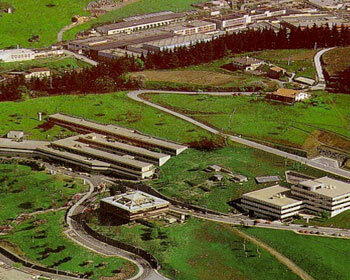Emilia Romagna is a diverse group of 8,000 cooperatives and family owned businesses that collaborate with each other in the Emilia Romagna region of Northern Italy. Their collaboration enables groups of small companies to jointly compete for large jobs that none of them could do alone. Their collaboration is aided by regional government supported business resource centers.
“Emilia Romagna came out of World War II as perhaps the most devastated region in Italy. Its strong cooperative and labor movements had been decimated by 25 years of Mussolini’s fascism that suppressed all independent organizations and jailed many co-op and union leader. Emilia Romagna ended up just behind the Nazi’s Gothic Line in 1943-45. It became the focus for Allied bombing, guerrilla warfare by the Resistance and Nazi reprisals against the civilian population. It emerged from the war impoverished with heavy unemployment.” John Logue, Economics, Cooperation and Employee Ownership, the Emilia Romagna Model http://dept.kent.edu/oeoc/oeoclibrary/emiliaromagnalong.htm
“The left-wing government in Emilia Romagna embarked on a strategy of promoting small business for economic development. It encouraged employee ownership, consumer cooperatives, and agricultural cooperatives, and it encouraged the development of cooperative institutions for all small businesses – co-ops and family owned firms alike.”John Logue, Economics, Cooperation and Employee Ownership, the Emilia Romagna Model http://dept.kent.edu/oeoc/oeoclibrary/emiliaromagnalong.htm
“The regional government’s economic development agency ERVET, created publicly funded small business ‘industrial sector service centers’ that have supported small business clustering in the region. They provide shared services in research and development, purchasing, education and training, workplace safety, technology transfer, marketing and distribution, exporting and more for scores or hundreds of small businesses in industrial sectors like ceramics, textiles, footwear, construction and agricultural machinery. These service centers combine the economies of scale with the advantages and flexibility of small business. They have supported the so called “flexible manufacturing” of the region in which small businesses in the same industry collaborate on joint bids for major contracts.” John Logue, Economics, Cooperation and Employee Ownership, the Emilia Romagna Model http://dept.kent.edu/oeoc/oeoclibrary/emiliaromagnalong.htmMajor firms supplied by these networks include Ferrari, Lamborghini, Maserati and Ducati. John Logue, Economics, Cooperation and Employee Ownership, the Emilia Romagna Model http://dept.kent.edu/oeoc/oeoclibrary/emiliaromagnalong.htm
Italy has a long cooperative history, and a number of laws that benefit co-ops including tax deductions for the funds they retain in collective reserves, and a requirement that co-ops contribute 3% percent of their annual profits to a co-op development fund run by one of the various co-op federations. John Logue, Economics, Cooperation and Employee Ownership, the Emilia Romagna Model http://dept.kent.edu/oeoc/oeoclibrary/emiliaromagnalong.htm
Unlike Mondragon – in Emilia Romagna multiple company types collaborate, including:
- Family owned
- Owned by communist cooperatives
- Owned by Catholic cooperative
- Owned by social democratic cooperatives
- Some cooperatives own publicly traded companies
Co-op federations include all sectors: workers, consumers, agricultural, and housing. Most companies are unionized. Coopitalia is a consumer co-op that is Italy’s largest retailer, comprised of 169 local retail co-ops and 4 million consumer members, though highly decentralized & democratic. Wal-Mart avoids Italy due to competition from Coopitalia.

 WAGES takes complete responsibility for planning, feasibility and launch of each co-op
WAGES takes complete responsibility for planning, feasibility and launch of each co-op Fagor started 14 years after the priest began his classes on self-management. Shortly thereafter they created a bank to help finance and to provide technical assistance to the various cooperative businesses in their group. The organizing drive to start their community bank was “savings or suitcases”. Fifty years later they have 85,000 people working in 120 companies with €38 billion of assets and annual revenue of €13 billion. Their industrial school is now an engineering and business university. Approximately 20,000 of those working in the co-ops are engineers. The co-ops jointly own second level co-ops that provide insurance, research and development and other services to the co-op companies that own them.
Fagor started 14 years after the priest began his classes on self-management. Shortly thereafter they created a bank to help finance and to provide technical assistance to the various cooperative businesses in their group. The organizing drive to start their community bank was “savings or suitcases”. Fifty years later they have 85,000 people working in 120 companies with €38 billion of assets and annual revenue of €13 billion. Their industrial school is now an engineering and business university. Approximately 20,000 of those working in the co-ops are engineers. The co-ops jointly own second level co-ops that provide insurance, research and development and other services to the co-op companies that own them.
 Groban Olson, corporate, and ESOP counsel since 1998, MBC has been able to establish and maintain its place as a worldwide manufacturing leader as well as a desirable, democratic, workplace. MBC is a full-service manufacturer of industrial brushes and paint brushes. The employees have one vote per person on shareholder issues, as in a co-op, and regularly participate in making company decisions.As an ESOP, MBC is uniquely positioned to compete in the global economy, establishing the company as one of the most progressive employers in the industry, the majority of whom do not offer similar programs.In 2000, the tenth year of the ESOP, MBC had experienced increased sales for the five preceding years and its stock value had increased by 133% since becoming an ESOP. From inception of the ESOP in 1990 through 2008, the company’s stock has consistently met or exceeded the earnings charted by the S&P, completely turning around MBC’s financial picture and its prospects going forward.In 2007, after paying off its stock acquisition debt, MBC elected Subchapter S status. As a 100% ESOP owned company, it was thereafter exempt from paying federal corporate income tax. These savings have enabled it to invest over $1,000,000 in the purchase and product development of its new Skylouver™ product.Since 2008, the maturing market for industrial brushes caused MBC to seek new product lines.In 2010, MBC invested in a start-up company making the SkyLouver™ technology (a combination skylight and solar thermal power collector) in exchange for manufacturing rights.MBC later decided to buy all the intellectual property rights to SkyLouver ™ to ensure successful management of the commercialization process.The new SkyLouver™ product line, launched in 2013, is expected to increase employment, employee ownership and profits. MBC will have shifted its product focus from a mature shrinking market to a dynamic growing one.In September 2010, the US Department of Energy in conjunction with the State of Maryland’s Clean Energy Economic Development Initiative (CEEDI) grant program, provided $770,000 to MBC to retool a production line at its Baltimore facility to manufacture SkyLouver™ products.MBC estimates that this project will result in 10 jobs in Baltimore during the first year. MBC has gone first to the Steelworkers to make the initial manufacturing worker hires for SkyLouver™. To accommodate its new product and market expansion, the company’s name is now MBC Ventures, Inc.
Groban Olson, corporate, and ESOP counsel since 1998, MBC has been able to establish and maintain its place as a worldwide manufacturing leader as well as a desirable, democratic, workplace. MBC is a full-service manufacturer of industrial brushes and paint brushes. The employees have one vote per person on shareholder issues, as in a co-op, and regularly participate in making company decisions.As an ESOP, MBC is uniquely positioned to compete in the global economy, establishing the company as one of the most progressive employers in the industry, the majority of whom do not offer similar programs.In 2000, the tenth year of the ESOP, MBC had experienced increased sales for the five preceding years and its stock value had increased by 133% since becoming an ESOP. From inception of the ESOP in 1990 through 2008, the company’s stock has consistently met or exceeded the earnings charted by the S&P, completely turning around MBC’s financial picture and its prospects going forward.In 2007, after paying off its stock acquisition debt, MBC elected Subchapter S status. As a 100% ESOP owned company, it was thereafter exempt from paying federal corporate income tax. These savings have enabled it to invest over $1,000,000 in the purchase and product development of its new Skylouver™ product.Since 2008, the maturing market for industrial brushes caused MBC to seek new product lines.In 2010, MBC invested in a start-up company making the SkyLouver™ technology (a combination skylight and solar thermal power collector) in exchange for manufacturing rights.MBC later decided to buy all the intellectual property rights to SkyLouver ™ to ensure successful management of the commercialization process.The new SkyLouver™ product line, launched in 2013, is expected to increase employment, employee ownership and profits. MBC will have shifted its product focus from a mature shrinking market to a dynamic growing one.In September 2010, the US Department of Energy in conjunction with the State of Maryland’s Clean Energy Economic Development Initiative (CEEDI) grant program, provided $770,000 to MBC to retool a production line at its Baltimore facility to manufacture SkyLouver™ products.MBC estimates that this project will result in 10 jobs in Baltimore during the first year. MBC has gone first to the Steelworkers to make the initial manufacturing worker hires for SkyLouver™. To accommodate its new product and market expansion, the company’s name is now MBC Ventures, Inc. 

